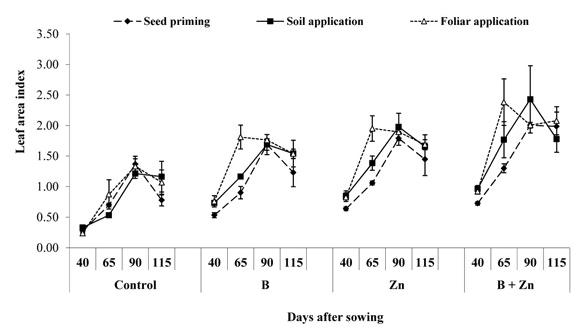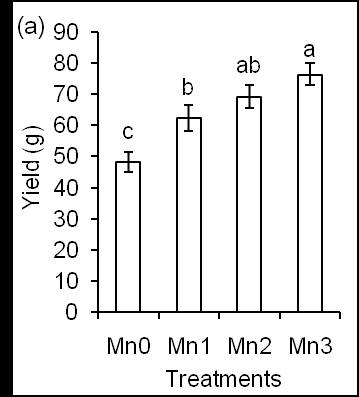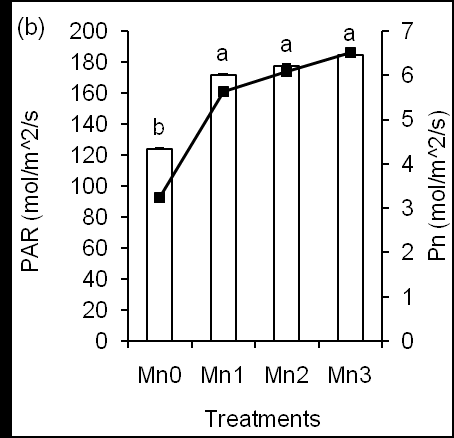October 14, 2020 at 1:38 am | Updated March 14, 2022 at 1:12 pm | 7 min read
With the pressure to increase food production, every agricultural practice that can be optimized for improving crop yield is under scrutiny; therefore, micronutrients, which are important for crop health and growth, are receiving more attention. Agronomists are increasingly studying different treatment methods to establish the easiest and most cost-effective way to improve micronutrient management. There are many small field tools available that give precise and immediate results to help agronomists test treatment results.
Importance of Plant Micronutrients
Micronutrients are needed only in small quantities. Nevertheless, they are essential for plant growth and health. A deficiency in any one of them can affect yield even when the major nutrients are abundant.
The common micronutrients are zinc (Zn), boron (B), magnesium (Mg), copper (Cu), calcium (Ca), manganese (Mn), iron (Fe), nickel (Ni), molybdenum (Mo), sulphur (S), and chloride (Cl).
Subscribe to the CID Bio-Science Weekly article series.
By submitting this form, you are consenting to receive marketing emails from: . You can revoke your consent to receive emails at any time by using the SafeUnsubscribe® link, found at the bottom of every email. Emails are serviced by Constant Contact
Manure and organic matter are rich in both micronutrients and macronutrients. However, the over-dependence on fertilizers has resulted in limiting the source of micronutrients. Chemical fertilizers have little or no micronutrients in them, and the high yielding crops use all that is available in the soils. Moreover, phosphate fertilizers restrict availability of iron, zinc, and copper for crops.
The micronutrients that are most often lacking are zinc and, to a lesser extent, boron and molybdenum.
In traditional and organic farming, manure is the main crop nutritional supplement that supplies most of the micronutrients. In industrial farming, micronutrients have to be added—as foliar sprays, seed treatments, or soil applications.
By monitoring aspects of plant growth that nutrients influence, it is possible to identify deficiency and suggest remedies. Let us consider some scenarios where different tools were used as examples.
LAI Tests for Foliar Applications of Zinc and Boron
Zinc is necessary to get high yields in crops. It is also one of the micronutrients that are most commonly limiting. It regulates stomata and is involved in creating an ionic balance that reduces tensions due to water deficiency. It is also essential for the synthesis of carbohydrates and protein.
Boron plays a major role in photosynthesis and in synthesis of carbohydrates and proteins. Both boron and zinc are necessary to increase yield and make a plant more stress-resistant
In rain-fed farms, the use of micronutrients is limited. Soil applications are not effective due to the scarcity of water, since these micronutrients are usually transported in a dissolved state. Foliar sprays and seed treatments can improve their uptake by plants.
Foliar applications of micronutrients are six to twenty times more effective than soil applications.
When applied as foliar sprays, zinc and boron are quickly absorbed through the leaves, which is the best route into the plants because the the leaves are the parts where these micronutrients are required. Boron can be applied in the early, middle, and late stages, along with the macronutrients or with zinc as a foliar spray.
Even when applied as a seed treatment, boron has been shown to halve the time needed for germination and results in a higher percentage of germination.
An experiment in Pakistan tested the efficiency of a combined foliar spray of zinc and boron in rain-fed maize. Zinc and boron were applied both combined and separately, as seed, soil, and foliar treatments.
The parameters measured were the Leaf area index (LAI), ground biomass, chlorophyll, and relative water content. The scientists used the CI-202 Portable Laser Leaf Area Meter from CID Biosciences to measure leaf area, from which LAI was calculated.
The CI-202 Leaf Area Meter is a handheld tool that, in a few seconds, makes non-destructive measurements of leaves with varying thicknesses. It records length, width, area, and perimeter of leaves and also calculates the aspect ratio. It can store 8000 measurements and can transfer data through a USB port.
The scientists found that of all the treatments tested, the combined spray of zinc and boron produced the best results in terms of leaf area index, chlorophyll concentrations, and relative water content (See Figure 1). Zinc and boron improved crop yield by 12% and 45%, respectively, compared to treatments where no foliar sprays were used.

Figure 1. “Leaf area index as affected by nutrient treatments and application methods ± S.E.,” Wasaya, et al., 2017. (Image credits: http://dx.doi.org/10.4067/S0718-95162017005000003)
Photosynthetic Rates Show Manganese Effects on Metabolism
Manganese is important for metabolic processes, such as photosynthesis, respiration, amino-acid synthesis, and hormone activation. It has a role in the use of light to split water molecules during photosynthesis.
Manganese’s deficiency impacts lignin biosynthesis in roots, increasing the chances of soil-borne fungal infections. Supplementation has been found to improve resistance of plants against soil-borne and leaf diseases. Its absence also makes the plant more susceptible to heat stress and causes increased loss of water through transpiration.
A study in Malaysia wanted to investigate the effectiveness of manganese supplementation by foliar spray in sandy soils to improve yield of forage maize.
Four different concentrations of manganese were tested. Scientists periodically monitored chlorophyll content, chlorophyll fluorescence, photosynthesis, and relative water content throughout the life of the crop. These plant parameters were correlated with the final yield. The number of leaves and plant height were also studied. To record net photosynthesis rate, the scientists used the CI-340 Handheld Photosynthesis System, produced by CID Biosciences.
The CI-340 is a portable tool that can measure photosynthesis, stomatal conductance, photosyhthetically active radiation (PAR), respiration, transpiration, and internal carbon dioxide (CO2). It is suitable for use on the field with either an open or closed system. It comes with ten different chambers to accommodate leaves of various sizes and control modules for temperature, light, and gases. It records photosynthesis as a measure of the difference in the CO2 that enters and leaves the leaf chamber. Results are obtained within a few seconds, which can be stored on the instrument and transferred later through a USB connection to computers.


Figure 2: Effects of different concentrations of Mn on yield (a) and photosynthesis rate (b, line graph) and photosynthetically active radiation (b, bar graphs). (Image credits: https://medwinpublishers.com/OAJAR/OAJAR16000109.pdf)
The scientists found that manganese sprays improved all the plant parameters observed; the higher amounts of spray were more effective. There were more leaves and plants were taller, resulting in more yield. Manganese also increased the chlorophyll content and rate of photosynthesis. This happened as the plants used more photosynthetically active radiation (PAR), See Figure 2.
With the help of simple tools, scientists could establish not only the positive effects of manganese, but also show exactly how the micronutrient achieved these effects.
Photosynthetic Rate Tracks Magnesium Amelioration by Mycrorhizae
Soil microbes and fungi play a major role in making nutrients available in forms that can be used by plants.
Arbuscular mycorrhiza fungi (AMF) live in the cells of the outer layer of the roots. They use photosynthates produced by plants as food; in return, they help the plants absorb macro- and micro- nutrients from the soil.
This symbiotic relationship is very common, and nearly 85% of plants have endomycorrhizae living in them. The AMF are considered to be natural bio fertilizers, and soils without them can impact plant metabolism.
Citrus plants are prone to suffer from magnesium deficiency, since this nutrient’s uptake by plants can be affected by soil water content, pH, temperature, and presence of other nutrients. It can cause chlorosis of leaves, as magnesium is an important component of chlorophyll. Lack of greenness results in influencing photosynthesis and, ultimately, the yield.
Luckily, the AMF have been known to grow more abundantly in soils lacking magnesium than soils rich in this micronutrient.
In a greenhouse experiment in China, scientists studied the effect of Glomus versiforme, an AMF, in Newhall, a navel orange (Citrus sinensis), and Ponkan, a tangerine (Citrus reticulate).
The researchers grew Newhall and Ponkan in soils with high and low amounts of magnesium. Once again, the CI-340 Handheld Photosynthesis System, from CID Biosciences, was used to quantify photosynthesis occurring in these two citruses.
Initially, in soils with low magnesium, Newhall seedlings suffered more than Ponkan, as they could absorb less magnesium, and that affected photosynthesis, reflected by low sugar levels in basal leaves.
After inoculation with the AMF, there was more of an improvement in photosynthesis in all citrus plants grown with low magnesium than in soils with high magnesium. The improvement was, however, greater in Newhall than Ponkan.
This proves that the effect of AMF depends on the species of plants and levels of magnesium. The more prone a plant is to suffer from magnesium deficiency, the more it benefits from the presence of AMF.
Bringing Science to the Field
In plant and agricultural research, it is important to track outer physical parameters and also gain an understanding of internal physiological processes to optimise plant growth and health. Instruments like the photosynthesis system and leaf area meter rapidly and easily provide vital information on the field. Scientists can save time and study more plants by getting results immediately instead of having to resort to complicated laboratory procedures. The economical nature of these tools has expanded the number of in-depth studies everywhere in the world. Thus, the instruments are valuable in spreading the application of science to solve everyday problems faced by farmers.
—
—
Vijayalaxmi Kinhal
Science Writer, CID Bio-Science
Ph.D. Ecology and Environmental Science, B.Sc Agriculture
Sources
Allah Wasaya, A., Shabir, M. S., Hussain, M., Ansar, M., Aziz, A., Hassan, W., & Ahmad, I. (2017). Foliar application of Zinc and Boron improved the productivity and net returns of maize grown under rainfed conditions of Pothwar plateau. J. Soil Sci. Plant Nutr, 17. DOI:http://dx.doi.org/10.4067/S0718-95162017005000003
Berruti, A., Lumini, E., Balestrini, R., & Bianciotto, V. (2016). Arbuscular Mycorrhizal Fungi as Natural Biofertilizers: Let’s Benefit from Past Successes. Frontiers in microbiology, 6, 1559. doi:10.3389/fmicb.2015.01559
Garcia, S., & Racsko, J. (2018, June). The Role of Arbuscular Mycorrhizal Fungi in Plant Nutrition. Retrieved from https://gpnmag.com/article/the-role-of-arbuscular-mycorrhizal-fungi-in-plant-nutrition/
Helias A. Udo de Haes, H. A., Voortman, R. L., Bastein, T., Bussink, D. W., Rougoor, C.W.,
van der Weijden, W. J.(2012). Scarcity of micronutrients in soil, feed, food, and mineral reserves – Urgency and policy options. Platform Agriculture, Innovation & Society. Retrieved from https://www.iatp.org/sites/default/files/scarcity_of_micronutrients.pdf
Miller, J. Soil micronutrients. Retrieved from https://extension.umd.edu/sites/extension.umd.edu/files/_images/programs/womeninag/Soil%20Micronutrients%20Final.pdf
Nozulaidi, M., NurInani, M., Khairi, M., & Jahan, S. M. D. (2016). Production of Corn; Effects of Manganese Application on Plant Parameters. J Agri Res, 1: 000109. Retrieved from https://medwinpublishers.com/OAJAR/OAJAR16000109.pdf
Xiao, J.X., Hu, C.Y., Chen, Y.Y., Yang, B., Hua, J. (2014). Effects of low magnesium and an arbuscular mycorrhizal fungus on the growth, magnesium distribution and photosynthesis of two citrus cultivars. Scientia Horticulturae, 177: 14-20. doi:https://doi.org/10.1016/j.scienta.2014.07.016
Related Products
Most Popular Articles
- Transpiration in Plants: Its Importance and Applications
- Leaf Area – How & Why Measuring Leaf Area…
- How to Analyze Photosynthesis in Plants: Methods and Tools
- Forest & Plant Canopy Analysis – Tools…
- The Forest Canopy: Structure, Roles & Measurement
- The Importance of Leaf Area Index (LAI) in…
- Root Respiration: Importance and Applications
- Stomatal Conductance: Functions, Measurement, and…
- Irrigating with Saline or Seawater
- Crop Water Use Efficiency Explained




